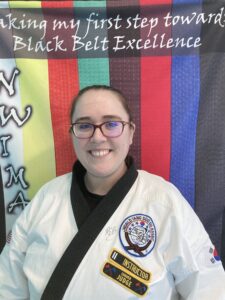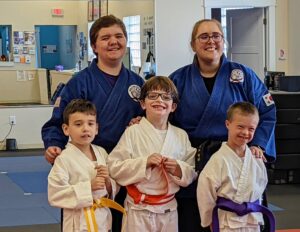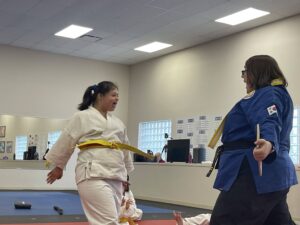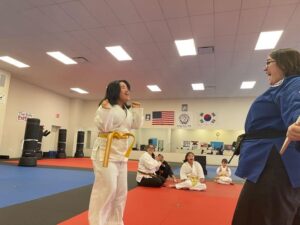Special Needs Karate
Special Needs Karate classes are 30 minutes long and take place weekly on Wednesday and Friday night from 6:00-6:30pm. These classes are designed for children with special needs ages 6-17.
Start your Journey to Black Belt!
Becoming a black belt is not just about kicking, punching, and knowing a lot of karate skills. The process of becoming a black belt involves goal-setting, consistency, hard work, perseverance, self-control, and confidence. At NWIMAA we encourage and support all of our students on their journey to black belt. The World Tang Soo Do Association that we are a part of has a path for students of all abilities to achieve black belt. While each individual’s journey is different we are confident that each of our students has the potential to achieve black belt!
Methods
Our special needs classes are taught in a way to help each student participate and perform at their best ability. Below are a few of the strategies we use to achieve this.
Positive Reinforcement
At NWIMAA we believe that positive reinforcement is the best way to
help our students learn the skills and character lessons we teach. That’s why we use a system to reward students who are making positive choices during class. Instead of reprimanding a student who is losing focus or making poor choices during class we prefer to reward the students next to them who are behaving correctly. This allows the student to change their behavior on their own in an effort to receive a reward as well.
English Language
In many of our classes at NWIMAA we use traditional commands in the Korean language. This is where our special needs karate program differs. All commands and instructions in our special needs karate class are given in English to help students understand and participate in class more easily.
Modeling
Martial arts instruction is built on modeling. The instructors demonstrate each skill and action the student is asked to complete before having the student execute it. Instructors also demonstrate proper respect and behavior during class so the student understands what is expected of them.
123 Magic
At NWIMAA, we use 123 Magic in all of our youth classes to help get students back on track when they are making bad choices in class. The instructor gives the student a count of three to change their behavior and make positive choices. If the student does not stop their behavior before the count of three is complete they are met with a calm and consistent consequence.
Scheduled Breaks
We know that students can have a hard time sustaining focus. That’s why our special needs class includes a quick break in the middle of class we call “race track”. Running the race track allows students to relax and move in a semi-structured way to allow better focus for the end of class.
Clear Expectations
Martial arts uses a system of commands and positive reinforcement to help students understand how to show respect and kindness to instructors and other students in class. This makes it easier for students to understand their role and expectations in class.
Predictable Structure
We understand that students can have difficulties with change. That’s why we try to keep our class structure predictable while changing the drills each week to keep the students focused and learning.
Class Structure
Bow-In
Each class begins with students showing respect by bowing to the flags and their instructors.
Warm-up
Then we start with a brief warm-up where the students will learn how to perform different exercises to get their body ready for karate class. These exercises include dynamic stretches and strength exercises that can be challenging for the students the first time they see them. But with instruction and encouragement the students build confidence and motor skills and are able to perform the exercises independently.
Character Chat
After the warm-up we gather for a quick character chat. Topics can include empathy, posture, anti-bullying techniques, self-defense, social skills, confidence, etc.
Basics
The class then moves on to basic technique instruction. The instructors will teach the students one or two basic karate techniques that will be the focus of the class for the day. Each technique is taught step by step to help the students understand and perform the technique at the level that they are able.
Drills
Next, we practice the basic techniques in a fun and engaging drill! These drills are designed to keep the students focused and energized while adding repetition and reinforcing the basic techniques already taught. Some examples include block practice with pool noodles, adding silly sound effects to our karate form, practicing kicks by hitting the pads, etc. The drill is followed by a quick run break and a final drill or two.
End of Class
Each class ends with a fun activity (our favorite is a snowball fight with fluffy cotton “snowballs”) and a 10 second meditation. We end class the same way we started by bowing to the flags, instructors, and helpers.
Meet your Instructor
Miss Emily Yothers is a third-degree black belt and certified instructor with the World Tang Soo Do Association. She began training in Tang Soo Do in 2010 at Valparaiso University under Master Adam Theros. Miss Yothers has a degree in music education from Valparaiso University and worked as an elementary music teacher for 3 years before making the transition to a full-time martial arts instructor in 2018. Miss Yothers started the Special Needs Karate program at NWIMAA in 2021. She has a passion for helping students with special needs exceed expectations and achieve their goals!





